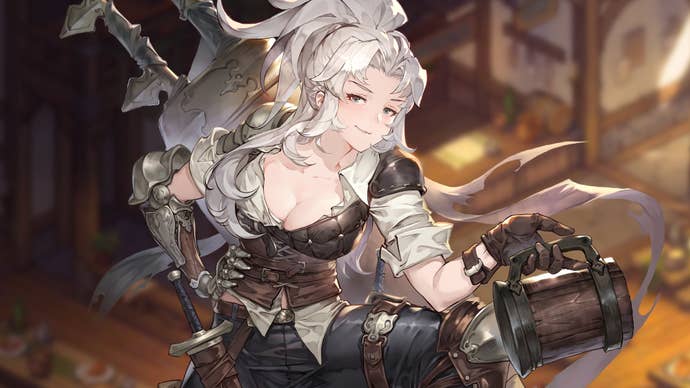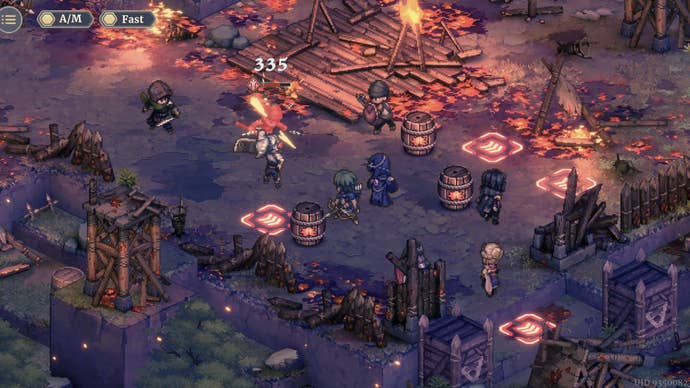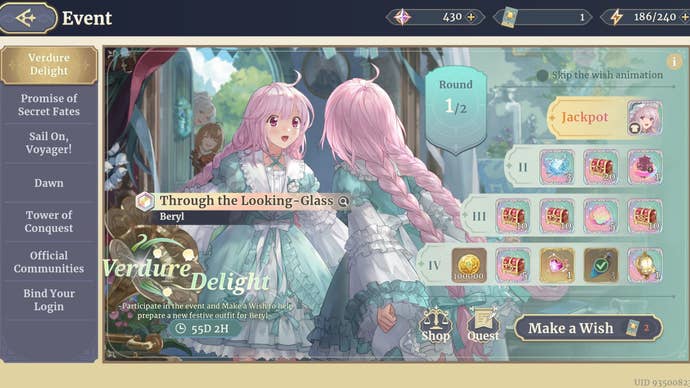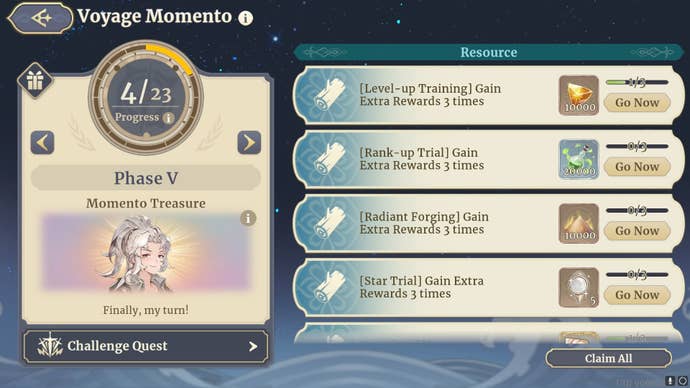How the Final Fantasy Tactics-like Sword of Convallaria won players over to become one of Steam’s best gacha games
From 'mixed' to 'mostly positive', XD's journey from sketchy launch to Steam stalwart hasn't been easy - but at least it's been educational.
Y’know, every game became Chinese so gradually, I didn’t even notice.
Between studios wholly owned by mega-publishers like Tencent and NetEase, their sub-labels like Level Infinite, and now various independent studios like Sword of Convallaria developer XD, the Chinese games industry is investing heavily in triple-A games of all kinds.
The scale and ambition of this investment is really easy to underestimate. Recently, a developer working on one of this year’s breakout survival hits, Once Human, said to me that its team and studio wasn’t very large - despite employing hundreds of people.
These are big budget games and, even when you play a lot of them, it’s still possible to get caught off guard by the scope and polish of what’s being produced; even when you factor in the creative liberties many of them take in mimicking mechanics from Nintendo and lifting UI design from competitors almost wholesale (we’re looking at you Wuthering Waves).
So when the big Japanese and Western publishers are struggling to land hits with some of their biggest IPs - with Starfield, Sony’s quiet 2023-24 and the recent output from Ubisoft and Square Enix all coming to mind - it’s not surprising that the Chinese industry is trying to step in and fill these gaps in the market. There are constant examples, particularly when it comes to flagship franchises which often go ten years between sequels.

What could be classed as surprising though, is that these Chinese games seem to have turned a reputational corner and started to become genuinely anticipated releases in the wider calendar in their own right. Just look at the domestic and international success of Black Myth: Wukong, or Hoyoverse adding Zenless Zone Zero to its huge slate of massive RPGs.
Another game to arrive in this vein is the aforementioned Sword of Convallaria from XD Games, capitalising on the clamour for grand, tactical RPGs in the style of Final Fantasy Tactics or Tactics Ogre.
But crucially, like the other successful games from Chinese studios, Sword of Convallaria doesn’t just take inspiration from these Japanese classics, but aims to deliver a meaningfully fresh spin on the genre as well.
“While Sword of Convallaria pays homage to the classic TRPGs that fans of the genre know and love, it sets itself apart through several innovative features and modern enhancements that elevate the player experience,” Guo Lei, Sword of Convallaria game director, says.
“One of the most significant differentiators is its dual-campaign narrative structure, which allows players to engage with both the Fool's Journey and the Spiral of Destinies—two parallel storylines that provide a rich, multi-layered narrative experience. This dual structure not only deepens the lore but also gives players the freedom to explore different facets of the game's world, offering a level of narrative complexity rarely seen in traditional TRPGs.

“The game’s dynamic battle system is another major selling point. Players can exploit terrain, utilise a variety of character abilities, and adapt their strategies on the fly, making each battle a unique and challenging experience. This system encourages replayability, as players can experiment with different tactics and team compositions to overcome various challenges.”
But while Sword of Convallaria strives to set itself apart mechanically, the first thing you notice is its glittering pixel art-style, which not only serves to differentiate its massive roster of characters and establish both the endless, starry space and rolling fields of its fantasy world, but put even more distance between it and its many anime-styled competitors.
“The choice of a 2.5D, classically-styled world was intentional to evoke the nostalgia of classic TRPGs while also standing out from the plethora of open-world gacha games,” Guo Lei explains. “This art style allows for detailed, expressive environments and characters that are both visually appealing and technically feasible on a wide range of devices. It also supports the game’s focus on tactical, grid-based combat, which is central to its gameplay.
“The 3D-like pixel visuals bring a fresh and vibrant look to the game, appealing to both longtime fans of pixel art and newcomers who appreciate polished, detailed aesthetics. It also enhances the gameplay by making the characters and environments more expressive and engaging, which is a significant evolution from the more static visuals of older TRPGs.”

It’s not just the art-style though, again, rather than just taking on the spirit of its inspirations, Sword of Convallaria took things a step further by actually hiring a composer who worked on the classic games it’s aiming to emulate. The resulting epic, orchestral score has its own ethereal vibe, with recurring flute motifs that further serve to mark Sword of Convallaria as its own distinct entity within the TRPG genre.
“Hitoshi Sakimoto was brought on early in the development process to ensure that the music would be fully integrated into the game’s design and narrative,” Guo Lei says.
“From the beginning, the intention was to collaborate with a composer of Sakimoto's calibre to capture the epic and emotional tone that Sword of Convallaria aims to convey. His experience on famous titles like Final Fantasy Tactics and Valkyria Chronicles made him the perfect fit to create a soundtrack that resonates with fans of classic TRPGs while also enhancing the game’s unique identity.”
Particularly for a free-to-play game, the scale of Sword of Convallaria is impressive, with a full TRPG’s length of good quality story content in just the Spiral of Destinies, then (a possibly more intriguing) meta-narrative around the Fool’s Journey.
The Spiral of Destinies serves as the core narrative, with your protagonist, as head of the Sword of Convallaria mercenary group, battling through advancing weeks of main story quests, side missions and very light city building, equipping and bolstering your town to whether the whims of each warring faction on your doorstep. Depending on the quests you complete, you can side with different factions, changing the flow of the story and relationships between characters, and each chapter lasts for hours of gameplay.

It’s also relatively separate from the random Gacha Game system, with a set amount of characters able to be used from your personal pool and many Legendary-tier characters appearing as playable guests in story missions. However, each chapter asks you to spend a “Key of Destiny” - two of which are given out for free a week - to enter. So if you run out and want to play more, you have to pay.
On the other hand, the Fool’s Journey operates as a parallel yet complementary narrative, offering more regular, but disconnected battles, as your squad of allies seeks to understand the nature of the time-frozen Sea of Chaos and the Calamities that threaten to tear apart reality, while experiencing moments in different characters’ lives.
This is where you get to draw on your full list of characters from the Gacha Store, and run into a time-limited “Endurance” system where you can only complete a certain number of levels per day - unless you pay with in-game currency to recharge.
“The decision to split Sword of Convallaria into the Fool’s Journey and Spiral of Destinies was rooted in a desire to offer players a richer and more layered storytelling experience that few games in the genre attempt,” Guo Lei says.
“This structure enhances replayability by encouraging players to experience the narrative from multiple perspectives. It also reflects the game’s thematic focus on destiny, choice, and the consequences of actions, where the two campaigns represent different facets of the same story universe—intertwined yet distinct.
“For those who are deeply invested in the overarching story, Spiral of Destinies offers a focused and comprehensive narrative. Meanwhile, players who enjoy delving into side content, exploring character lore, and understanding the finer details of the world will find the Fool’s Journey to be an engaging way to experience the game from different angles.”

The Endurance limit on how much you can play the Fool’s Journey and Keys of Destiny in the Spiral of Destinies has proven controversial though, but the development team feels it’s a necessary barrier to make Sword of Convallaria a longer-term game than a traditional TRPG.
“The Endurance system and Keys of Destiny are designed to pace the game’s progression and add layers of strategy,” Guo Lei states.
“The Endurance system requires players to manage their characters' stamina, preventing them from overextending and adding a realistic element of resource management. The Keys of Destiny regulate access to the Spiral of Destinies, encouraging players to make thoughtful decisions about when and how to progress through the game’s branching storylines. Without these systems, players might rush through content, missing out on the strategic depth and narrative richness that the game offers.”
“The JRPG and tactical RPG genres are beloved by a dedicated group of gamers, but making the game free-to-play lowers the barrier to entry, allowing more players to experience the rich story and deep tactical gameplay. Additionally, the free-to-play model with premium elements supports continuous content updates and engagement, ensuring that the game can evolve and expand over time, thus providing long-term value for both players and the developers.
“Sword of Convallaria is designed to be a long-term project. The ambition is to create a rich, evolving world that continues to engage players with new content, events, and updates over the years to come. The game’s structure, with its dual campaigns and paid elements, supports this model, allowing for the regular introduction of new characters, storylines, and gameplay mechanics. The goal is to cultivate a dedicated player base that finds both the narrative and gameplay rewarding enough to stay engaged over the long term.”
These progression stoppers, as well as the game’s Gacha Game character unlocks, led to Sword of Convallaria receiving a “Mixed” reception on Steam, at least initially.

Recent weeks have seen its Steam rating climb to “Mostly Positive”, which XD puts down to players actually getting to grips with what’s actually offered within the free-to-play structure.
“We feel the initial ‘mixed’ reception of Sword of Convallaria can largely be attributed to its innovative approach, which blended classic tactical RPG elements with a modern free-to-play model,” Guo Lei explains.
“The game introduced a dual-narrative structure, where players could experience both the Fool’s Journey and Spiral of Destinies, each offering different perspectives and gameplay styles. While this approach was bold and offered a fresh take on storytelling within the genre, it also required players to adapt to a new and complex structure that isn’t typical in traditional JRPGs.
“As with many innovative games, Sword of Convallaria needed time to find its audience. Early players may have found the game’s mechanics and narrative structure to be unfamiliar or challenging, especially when compared to more conventional titles. The game’s attempt to merge deep, story-driven content with the expectations of a live-service model also meant that it took some time for players to fully appreciate its depth and ambition.
“However, as more players spent time with the game and began to understand and embrace its unique approach, the appreciation for what Sword of Convallaria offers grew. The game’s depth, strategic complexity, and narrative richness became more apparent, leading to a more positive reception over time.
“To support this, the development team continued to refine the game post-launch, based on early feedback. They improved onboarding to better guide players through the dual narratives, ensuring that the game’s innovative features were presented in a way that was easier to grasp. Regular updates and patches also helped smooth out the initial rough edges, making the game more accessible without compromising its complexity.
“As a result, Sword of Convallaria has steadily built a dedicated community of players who appreciate its ambition and unique approach, leading to the improvement in its Steam rating from “mixed” to “mostly positive.” This journey reflects how innovation in game design sometimes requires time and player engagement to be fully recognized and appreciated.”
Sword of Convallaria is out now on Steam, iOS and Android.









